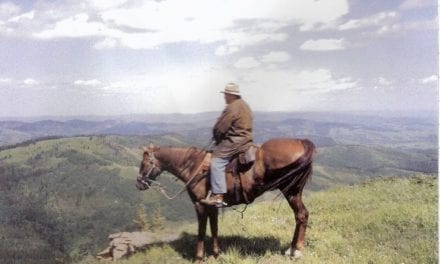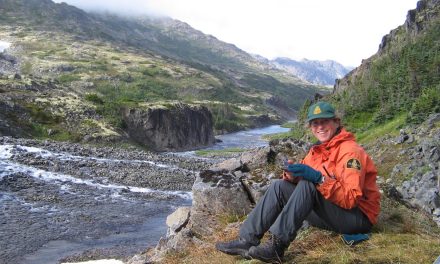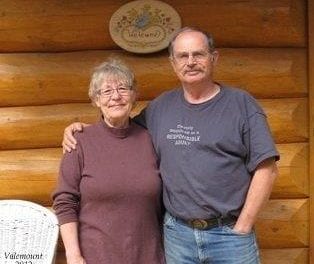When I took over as the Chief Warden, Perry had been managing the Ya Ha Tinda out of Invermere and I was able to take over the portfolio of managing that place as well. That was also a highlight of my career. The Ya Ha Tinda is special to all of us in the mountain parks in many ways and to have a hand in how that place evolved was great for me, and very rewarding.
SH: Okay and then as Superintendent your responsibilities in Waterton? What were some of the issues there?
Ian: There were a couple of things that were on the plate while I was there. One of them was the Parks owned pool occupied a big chunk of land in the centre of town and the pool wasn’t being used that much anymore. Parks Canada decided to do a call for proposals for that piece of land, and we worked through releasing that land to a successful proponent in building a bit of a resort there, on that piece of land. That had a significant change. The construction hadn’t started too much by the time I left but I was involved in the design with the developer, with lots of assistance from Regional Office (Gail Harrison) on that one.
The Prince of Wales was owned by Dial Corporation, run by Glacier Park Incorporated of Glacier Park. Dial owned big companies in Banff with Brewster Bus Lines, the Mount Royal Hotel, the Icefields Centre, Sulphur Mountain Gondola. Glacier Park Inc. came forth with a proposal to upgrade and build some more units for the Prince of Wales Hotel. That was somewhat controversial. We worked through that process, and I remember meeting the then President of Dial Corporation, a fellow named John Teats. Kevin Van Tighem and I took him for a helicopter flight. I thought that it would be a good idea to show him what some of the ecological concerns were from the air. We were able to take him up and show him the valley constrictions and how wildlife moved and how that development could potentially impact that. They seemed quite concerned about public perceptions etc. Gail was a big help on it as well. That process took quite a bit of time and in the end I think Dial realized they didn’t want to rebuild the Prince of Wales…and didn’t.
One of the other success stories in my mind, the Waterton Management Plan was pretty specific about an area called the Blakiston Fan which was right in the middle of the main valley. Parks Canada had a big maintenance storage area on it, all sorts of old construction material and equipment was stored (an equipment graveyard ) there. In order for the Management Plan to be fulfilled, that stuff needed to be removed.
We were trying to figure out how this would actually work and I asked the Finance Manager, Diane Cooper, to see if we could hold some sort of auction of that material, and could we retain the revenues. Diane worked very hard with Calgary and Ottawa finance types, to convince them not only to allow the sale of government goods in an auction, but to retain the proceeds locally as well! To make a long story short it took a while for staff to get on board with getting rid of their hordes of materials. The compound was running out of space as well, with accumulated “stuff”. The park management made a deal with the Trades Department and the Highways Department and the Warden Service, and others that if they donated stuff, we’d split up the money between the groups so they would have some of the spoils of the action, and retain some for general park visitor improvements. It kind of encouraged them to reduce the amount of stuff they had. I remember talking to Randall Schwanke, I think there were 25 old fire pumps that had been replaced by 25 or 30 new ones. So there were lots of cases like that where old equipment was still useful, just not used anymore, and was just being stored. So we were starting to run out of storage space in the compound. Momentum built and staff got involved and it was a big event in the fall. Surplus vehicles, a horse trailer and a horse. Culverts, plumbing stuff, fencing…you name it.
A local cottager Ken Hurlburt owned Fort McLeod Auction and had been a Member of Parliament at one time. He was thrilled to get involved and do the auction for us. He arranged to have people parking cars and that sort of thing as well as run the auction. I thought it might go well because the local ranchers always need stuff, culverts and fire pumps and all that kind of stuff. The day the auction was held, I’m going to guess 400 people showed up at least. I knew things were probably going to go pretty well, when of those people who came, most brought pick up trucks and horse trailers, so they were there to buy. Everything went, and we solved our problem of getting rid of stuff on the Blakiston Fan, the goal of the Management Plan, and increasing space at the compound in one fell swoop, and made about $150,000.00 to boot, which was reinvested back into the park.
When I came back to Banff, Charlie Zinkan asked me to do the same thing in Banff. We had a lot of stuff in the old stores and compound, the buffalo paddock had just been removed so there was all kinds of fencing and posts and gates, all that kind of stuff, old vehicles. So we had another one in Banff , the auctioneer was thrilled to participate again and Banff made a bunch of money. Fun things like that, they were new initiatives to Parks.
SH: What did you like about being a Warden? What didn’t you like about being a Warden?
Ian: There was not too much I didn’t like. What I liked about it was the variety. Lake Louise was seasonally very busy. In winter a group of wardens went to the ski hill for avalanche control, others did duty warden shifts/projects etc in the valley. In the late ‘80s the Warden Service was actually involved in being first responders to highway accidents and first response in an ambulance role. One of Charlie Zinkan’s thrusts was the federal government was actually paying the ID, the Improvement District, a significant amount of money to provide ambulance services in Banff Park and we were fulfilling that role, and no money. I was tasked to get us out of being the ambulance service which was not our role. First response was largely very tough on staff, getting called up to the Chateau and having to deal with somebody having a heart attack in the middle of the night.. or worse. Highway accidents were particularly grim. Incident Stress was just starting to be recognized as a potential impact we needed to deal with. We got out of first response; it was not easy but we got out of that role and it allowed us to do other things.
During that time as well, because of incidents in Banff, moved (away) from open in-park garbage pits where grizzly bears and black bears congregated, and kept us very busy with bears around the Chateau and lower Lake Louise, and in Banff the same thing. All garbage was stored in bear proof bins then hauled outside of Banff National Park. For a few years there we had a number of very habituated bears without a food source anymore and created a LOT of work for our problem wildlife people and warden staff. And monitoring to ensure the bins were in fact bear proof. Warden staff did a lot of work in trapping and moving bears and occasionally destroying bears. Over time that bear population, studied by Mike Gibeau (Dr.), went from a highly habituated set of bears to a much “wilder” population that depended on natural food sources, rather than artificial foods that came from these dumps.
One of the related things for me at that time, in the late ‘80s in Lake Louise … was a bear up the Banff Jasper Highway called Blondie. Her home range included some of the ditches along the highway (93N). She was rarely fed artificial foods but that was where she lived, and she created lots of issues with bear jams, and was a prime candidate for becoming habituated. Ron LeBlanc came to me and said, “Maybe we need to think about aversive conditioning”. It was starting to be done in the United States and Ron did a bunch of research on the types of weapons being used, success rates etc. Ron and I figured out that we should try something called an Arwin Gun, a riot gun developed for crowd use in Ireland. It shot big rubber bullets so we bought one them as a trial and started doing aversive conditioning on Blondie. It turned out to be a big success, where she was not removed from her home territory, but learned that roadsides weren’t a good place to be. (It was) Manpower intensive but worth it. Aversive conditioning really transformed how we managed bears that came into the townsite or the campsites and were candidates for habituation and larger problems. We didn’t simply trap and remove them into the backcountry of Banff where either they would come back to town quicker than the helicopter did or get killed in another bear’s territory. We actually started to teach the bears what were appropriate places to be, and I think that’s largely why grizzly bears continue to exist in the Bow Valley. I know that folks still work hard on aversive conditioning but in my mind, it was Ron LeBlanc and the Arwin Gun that started that whole thing on the Banff Jasper Highway. We didn’t use the Arwin long, but it got us started.
What made the job interesting? There was the public safety component in Lake Louise …. Public Safety (lead rescues and searches) in the summertime was a huge issue. The general Warden Service was trained to participate in those rescues, maybe not to lead them but we were all involved in some fairly significant rescues and searches. Clair (Israelson)) and Gord (Irwin) did an amazing job training us and leading the Public Safety section.
Then there was the fall boundary hunting, poaching patrols, backcountry districts. I think the variety intrigued us all. But with Health and Safety protocols, and the way things evolved, specialization started to take over, and we ended up where we did.
SH: Do you want to expand on what you didn’t like?
Ian: There wasn’t much I didn’t like to tell you the truth. I felt that I tried to work a lot with the other functions. That sort of came to play in the late ‘80s with the four in Lake Louise … the Interpreter Manager, Townsite Manager in Lake Louise, Highways and the Warden Service Since we worked well together, we did things like having wardens go to the brand new visitor centre in Lake Louise and give impromptu talks about things that they did in their work. Wildlife telemetry, public safety, horse work etc. I think that accomplished two things in that it gave staff confidence to talk to the public and it also gave the public a chance to further understand what these guys in the uniforms and the hats actually did. I was kind of proud of that. Working with other functions was something that I particularly enjoyed. Parks Canada was bigger than just the Warden Service.
So, was there anything I didn’t like? There’s nothing that jumps to mind. I think that we all had moments through budget cuts/reorganizations and those sorts of things, there was a lot of concern over changes that were affecting the Warden Service but by and large, because of the maturity of the staff I had, in Banff people generally understood the direction and the reasoning why. Maybe not liked…
One of the unique things in Banff were Wednesday morning meetings in the coffee room. Bob Haney had initiated them in the Warden Office, so that once a week staff of all functions would update what they were working on, and there was lots between fire, wildlife research, aquatics, public safety, cultural resource management, law enforcement…I think it helped staff get a better understanding of what the diverse group of specialties were up to, and why. Actually as you recall Sue, the Banff Field Unit kind of glommed onto the meetings because the rest of the park didn’t know what was going on in the Warden Office either, so Wednesday morning meeting minutes were generated and posted for all the Parks staff. That was one thing that I tried very hard to do, to work with other functions like trades, and highways service centre, visitor services, interpretation. We had good management teams in Parks at that time. (Tape 42:46)
SH: What are some of the more memorable events of your Warden Service career?
Ian: Like most people we could talk for the next five days about memorable events, but I think a couple of ones that stand out, certainly in the public safety world.
In Lake Louise a lone hiker went missing in the Bow Glacier area above Bow Lake and there was massive multi day search for this fellow involving staff of Banff Warden Office and Lake Louise. They were put by helicopter into remote areas around Bow Lake looking for footprints or signs, or anything of this fellow.
Ferris was his first name. It was a big, big search and it was getting onto maybe the third day, it wasn’t looking very good. No sign of him. The rescue coordinators were starting to talk about winding down. I remember Tim Auger was doing a low level flight on the glacier and at the last moment caught a glimpse down a crevasse that went not vertically down, but almost horizontal to the surface, so that if you looked down into this thing from above you would never see anything, but with the helicopter rising just above ground level, he was able to look into this thing and saw a bit of colour, circled around, and sure enough there was this fellow in the crevasse. It was steep enough that he couldn’t crawl out but was visible from the air from this particular angle and flight, and we successfully got that fellow out alive. It was an immense search.
Another big search out of Banff Warden Office was when I was Chief (Warden) at that point, was when Ian Pengelly was at Windy Cabin and a dog with a backpack showed up and nobody else. No human was around. So that raised a few alarms. With some research we found through a backcountry permit that there was an individual registered to hike, starting in Lake Louise, going up the Pipestone River, over to the Red Deer River, down to Scotch Camp, up to Windy Cabin and then up over the North Cascade Pass and down into Flints Park, then up and over Badger Pass into Johnsons creek and out. A BIG hike. He was going with his two dogs. One had turned up at Windy from who knows where.
We did a multi day search, in not all that good weather. Wardens were helicoptered to different points along that whole route, looking for tracks of this fellow. Narrowed it down to somewhere between Windy and going into Johnston Creek over Badger Pass. He could have got lost in that area. Most of the Warden Service in Banff had some familiarity with the area, having been in a district role, when you would do a horse trip through that country. A couple trip up points were possible, a side valley up the Panther River towards the North Cascade pass, or as you come up to Badger Pass, there’s a trail leading off that that drops you into nowhere if you didn’t make the sharp left turn to go over the pass. I think I remember telling Brad White, check on the other side of that Col because you drop down into some not so great country, glaciers and those sorts of things. It took a bit because the weather was so bad, but Brad flew up that way, got through that Col on to the other side near the Bonnet Glacier, and sure enough there was the fellow. His tent had just blown into a glacial lake. He had pretty much given up on life, he wasn’t going to get rescued, and we found him alive, and the other dog who he was feeing his last food too. To me, with that intimate knowledge of the park that the Warden Service had at that time, we were able to finally figure out where he might have gone, in an area that covers most of north Banff Park.



